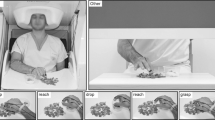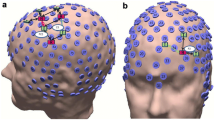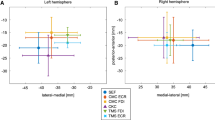Abstract
This magnetoencephalography (MEG) study aims at characterizing the coupling between cerebellar activity and the kinematics of repetitive self-paced finger movements. Neuromagnetic signals were recorded in 11 right-handed healthy adults while they performed repetitive flexion–extensions of right-hand fingers at three different movement rates: slow (~ 1 Hz), medium (~ 2 Hz), and fast (~ 3 Hz). Right index finger acceleration was monitored with an accelerometer. Coherence analysis was used to index the coupling between right index finger acceleration and neuromagnetic signals. Dynamic imaging of coherent sources was used to locate coherent sources. Coupling directionality between primary sensorimotor (SM1), cerebellar, and accelerometer signals was assessed with renormalized partial directed coherence. Permutation-based statistics coupled with maximum statistic over the entire brain volume or restricted to the cerebellum were used. At all movement rates, maximum coherence peaked at SM1 cortex contralateral to finger movements at movement frequency (F0) and its first harmonic (F1). Significant (statistics restricted to the cerebellum) coherence consistently peaked at the right posterior lobe of the cerebellum at F0 with no influence of movement rate. Coupling between Acc and cerebellar signals was significantly stronger in the afferent than in the efferent direction with no effective contribution of cortico-cerebellar or cerebello-cortical pathways. This study demonstrates the existence of significant coupling between finger movement kinematics and neuromagnetic activity at the posterior cerebellar lobe ipsilateral to finger movement at F0. This coupling is mainly driven by spinocerebellar, presumably proprioceptive, afferences.


Similar content being viewed by others
References
Manto M, Bower JM, Conforto AB, Delgado-Garcia JM, da Guarda SN, Gerwig M, et al. Consensus paper: roles of the cerebellum in motor control--the diversity of ideas on cerebellar involvement in movement. Cerebellum. 2012;11:457–87.
Clarac F. Some historical reflections on the neural control of locomotion. Brain Res Rev. 2008;57:13–21.
Spencer RM, Verstynen T, Brett M, Ivry R. Cerebellar activation during discrete and not continuous timed movements: an fMRI study. NeuroImage. 2007;36:378–87.
Spencer RM, Ivry RB, Zelaznik HN. Role of the cerebellum in movements: control of timing or movement transitions? Exp Brain Res. 2005;161:383–96.
Jancke L, Specht K, Mirzazade S, Peters M. The effect of finger-movement speed of the dominant and the subdominant hand on cerebellar activation: a functional magnetic resonance imaging study. NeuroImage. 1999;9:497–507.
Ivry RB, Keele SW, Diener HC. Dissociation of the lateral and medial cerebellum in movement timing and movement execution. Exp Brain Res. 1988;73:167–80.
Eccles JC. Circuits in the cerebellar control of movement. Proc Natl Acad Sci U S A. 1967;58:336–43.
Thach WT, Goodkin HP, Keating JG. The cerebellum and the adaptive coordination of movement. Annu Rev Neurosci. 1992;15:403–42.
Bastian AJ, Martin TA, Keating JG, Thach WT. Cerebellar ataxia: abnormal control of interaction torques across multiple joints. J Neurophysiol. 1996;76:492–509.
Blakemore SJ, Wolpert DM, Frith CD. The cerebellum contributes to somatosensory cortical activity during self-produced tactile stimulation. NeuroImage. 1999;10:448–59.
Marty B, Bourguignon M, Op de Beeck M, Wens V, Goldman S, Van Bogaert P, et al. Effect of movement rate on corticokinematic coherence. Neurophysiol Clin. 2015;45:469–74.
Bourguignon M, Jousmaki V, Op de Beeck M, Van Bogaert P, Goldman S, De Tiege X. Neuronal network coherent with hand kinematics during fast repetitive hand movements. NeuroImage. 2012;59:1684–91.
Bourguignon M, De Tiege X, Op de Beeck M, Pirotte B, Van Bogaert P, Goldman S, et al. Functional motor-cortex mapping using corticokinematic coherence. NeuroImage. 2011;55:1475–9.
Piitulainen H, Bourguignon M, De Tiege X, Hari R, Jousmaki V. Corticokinematic coherence during active and passive finger movements. Neuroscience. 2013;238:361–70.
Bourguignon M, Piitulainen H, De Tiege X, Jousmaki V, Hari R. Corticokinematic coherence mainly reflects movement-induced proprioceptive feedback. NeuroImage. 2015;106:382–90.
Bourguignon M, Jousmaki V, Marty B, Wens V, Op de Beeck M, Van Bogaert P, et al. Comprehensive functional mapping scheme for non-invasive primary sensorimotor cortex mapping. Brain Topogr. 2013;26:511–23.
Butz M, Timmermann L, Gross J, Pollok B, Dirks M, Hefter H, et al. Oscillatory coupling in writing and writer's cramp. J Physiol Paris. 2006;99:14–20.
Timmermann L, Gross J, Dirks M, Volkmann J, Freund H, Schnitzler A. The cerebral oscillatory network of parkinsonian resting tremor. Brain. 2003;126:199–212.
Pollok B, Sudmeyer M, Gross J, Schnitzler A. The oscillatory network of simple repetitive bimanual movements. Brain Res Cogn Brain Res. 2005;25:300–11.
Pollok B, Krause V, Butz M, Schnitzler A. Modality specific functional interaction in sensorimotor synchronization. Hum Brain Mapp. 2009;30:1783–90.
Gross J, Timmermann L, Kujala J, Dirks M, Schmitz F, Salmelin R, et al. The neural basis of intermittent motor control in humans. Proc Natl Acad Sci U S A. 2002;99:2299–302.
Jerbi K, Lachaux JP, N'Diaye K, Pantazis D, Leahy RM, Garnero L, et al. Coherent neural representation of hand speed in humans revealed by MEG imaging. Proc Natl Acad Sci U S A. 2007;104:7676–81.
Piitulainen H, Bourguignon M, De Tiege X, Hari R, Jousmaki V. Coherence between magnetoencephalography and hand-action-related acceleration, force, pressure, and electromyogram. NeuroImage. 2013;72:83–90.
Oldfield RC. The assessment and analysis of handedness: the Edinburgh inventory. Neuropsychologia. 1971;9:97–113.
De Tiege X, Op de Beeck M, Funke M, Legros B, Parkkonen L, Goldman S, et al. Recording epileptic activity with MEG in a light-weight magnetic shield. Epilepsy Res. 2008;82:227–31.
Carrette E, Op de Beeck M, Bourguignon M, Boon P, Vonck K, Legros B, et al. Recording temporal lobe epileptic activity with MEG in a light-weight magnetic shield. Seizure. 2011;20:414–8.
Taulu S, Simola J, Kajola M. Applications of the signal space separation method. Signal Process IEEE Trans. 2005;53:3359–72.
Bortel R, Sovka P. Approximation of statistical distribution of magnitude squared coherence estimated with segment overlapping. Signal Process. 2007;87:1100–17.
Halliday DM, Rosenberg JR, Amjad AM, Breeze P, Conway BA, Farmer SF. A framework for the analysis of mixed time series/point process data--theory and application to the study of physiological tremor, single motor unit discharges and electromyograms. Prog Biophys Mol Biol. 1995;64:237–78.
Marty B, Bourguignon M, Jousmaki V, Wens V, Op de Beeck M, Van Bogaert P, et al. Cortical kinematic processing of executed and observed goal-directed hand actions. NeuroImage. 2015;119:221–8.
Reuter M, Schmansky NJ, Rosas HD, Fischl B. Within-subject template estimation for unbiased longitudinal image analysis. NeuroImage. 2012;61:1402–18.
Gramfort A, Luessi M, Larson E, Engemann DA, Strohmeier D, Brodbeck C, et al. MNE software for processing MEG and EEG data. NeuroImage. 2014;86:446–60.
Gross J, Kujala J, Hamalainen M, Timmermann L, Schnitzler A, Salmelin R. Dynamic imaging of coherent sources: studying neural interactions in the human brain. Proc Natl Acad Sci U S A. 2001;98:694–9.
Van Veen BD, van Drongelen W, Yuchtman M, Suzuki A. Localization of brain electrical activity via linearly constrained minimum variance spatial filtering. IEEE Trans Biomed Eng. 1997;44:867–80.
Rosenberg JR, Amjad AM, Breeze P, Brillinger DR, Halliday DM. The Fourier approach to the identification of functional coupling between neuronal spike trains. Prog Biophys Mol Biol. 1989;53:1–31.
Schelter B, Timmer J, Eichler M. Assessing the strength of directed influences among neural signals using renormalized partial directed coherence. J Neurosci Methods. 2009;179:121–30.
Schelter B, Winterhalder M, Eichler M, Peifer M, Hellwig B, Guschlbauer B, et al. Testing for directed influences among neural signals using partial directed coherence. J Neurosci Methods. 2006;152:210–9.
Schneider T, Neumaier A. Algorithm 808: ARFIT—A Matlab package for the estimation of parameters and Eigenmodes of multivariate autoregressive models. ACM Trans Math Softw. 2001;27:58–65.
Faes L, Pinna GD, Porta A, Maestri R, Nollo G. Surrogate data analysis for assessing the significance of the coherence function. IEEE Trans Biomed Eng. 2004;51:1156–66.
Nichols TE, Holmes AP. Nonparametric permutation tests for functional neuroimaging: a primer with examples. Hum Brain Mapp. 2002;15:1–25.
Bourguignon M, De Tiege X, de Beeck MO, Van Bogaert P, Goldman S, Jousmaki V, et al. Primary motor cortex and cerebellum are coupled with the kinematics of observed hand movements. NeuroImage. 2012;66:500–7.
Piitulainen H, Bourguignon M, Hari R, Jousmaki V. MEG-compatible pneumatic stimulator to elicit passive finger and toe movements. NeuroImage. 2015;112:310–7.
Stoodley CJ, Schmahmann JD. Functional topography in the human cerebellum: a meta-analysis of neuroimaging studies. NeuroImage. 2009;44:489–501.
Ruspantini I, Saarinen T, Belardinelli P, Jalava A, Parviainen T, Kujala J, et al. Corticomuscular coherence is tuned to the spontaneous rhythmicity of speech at 2-3 Hz. J Neurosci Off J Soc Neurosci. 2012;32:3786–90.
Macdougall H, Moore S. Marching to the beat of the same drummer: the spontaneous tempo of human locomotion. J Appl Physiol. 2005;99:1164–73.
Bisio A, Avanzino L, Lagravinese G, Biggio M, Ruggeri P, Bove M. Spontaneous movement tempo can be influenced by combining action observation and somatosensory stimulation. Front Behav Neurosci. 2015;9.
Bove M, Tacchino A, Pelosin E, Moisello C, Abbruzzese G, Ghilardi MF. Spontaneous movement tempo is influenced by observation of rhythmical actions. Brain Res Bull. 2009;80:122–7.
Bosco G, Poppele RE. Proprioception from a spinocerebellar perspective. Physiol Rev. 2001;81:539–68.
Acknowledgements
This study was supported by research grants from the Fonds de la Recherche Scientifique (FRS-FNRS, Belgium; Grant references: J.0097.13F, J.0095.16F). Mathieu Bourguignon has been supported by the program Attract of Innoviris (Grant 2015-BB2B-10). Gilles Naeije is supported by a research grant of the Fonds Erasme (Brussels, Belgium). Xavier De Tiège is Postdoctoral Clinical Master Specialist at the Fonds de la Recherche Scientifique (FRS-FNRS, Belgium). The MEG project at the CUB Hôpital Erasme is financially supported by the Fonds Erasme (Research Convention “Les Voies du Savoir”, Brussels, Belgium). Brice Marty also thanks Professor Stéphane Swillens at the Université libre de Bruxelles (ULB) for his support.
Author information
Authors and Affiliations
Corresponding author
Ethics declarations
Conflict of Interest
The authors declare that they have no conflict of interest.
Rights and permissions
About this article
Cite this article
Marty, B., Wens, V., Bourguignon, M. et al. Neuromagnetic Cerebellar Activity Entrains to the Kinematics of Executed Finger Movements. Cerebellum 17, 531–539 (2018). https://doi.org/10.1007/s12311-018-0943-4
Published:
Issue Date:
DOI: https://doi.org/10.1007/s12311-018-0943-4




